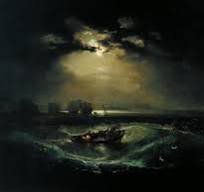The Timeless Beauty of Turner Paintings
Joseph Mallord William Turner, commonly known as J.M.W. Turner, was a British artist whose paintings continue to captivate audiences worldwide with their ethereal beauty and masterful use of light and color. Born in 1775, Turner is considered one of the greatest landscape painters in art history, known for his innovative techniques and evocative depictions of nature.
Turner’s paintings often showcase dramatic seascapes, serene landscapes, and atmospheric effects that blur the line between reality and imagination. His ability to capture the fleeting moments of light and weather conditions on canvas is unparalleled, creating a sense of movement and emotion in his works.
One of Turner’s most famous works is “The Fighting Temeraire,” which depicts the majestic ship being towed away to be broken up for scrap. The painting symbolizes the end of an era and the inevitable passage of time, rendered with a haunting beauty that resonates with viewers even today.
Turner’s later works became increasingly experimental, with bold brushstrokes and vibrant colors that pushed the boundaries of traditional painting. His innovative approach to composition and light inspired future generations of artists, earning him a lasting legacy as a visionary painter.
Today, Turner’s paintings can be found in major museums and private collections around the world, cherished for their timeless beauty and emotional depth. His ability to capture the sublime beauty of nature continues to inspire art lovers and aspiring artists alike, reminding us of the enduring power of art to transcend time and touch the soul.
Experience the mesmerizing world of Turner paintings and immerse yourself in the enchanting landscapes that have stood the test of time.
Exploring the Legacy of J.M.W. Turner: Frequently Asked Questions About His Life, Art, and Influence
- 1. Who was J.M.W. Turner?
- 2. What are some famous Turner paintings?
- 3. What makes Turner’s paintings unique?
- 4. How did Turner influence the art world?
- 5. Where can I see Turner’s paintings?
- 6. What themes did Turner often depict in his works?
- 7. How did Turner’s style evolve over his career?
1. Who was J.M.W. Turner?
Joseph Mallord William Turner, known as J.M.W. Turner, was a renowned British artist born in 1775. He is celebrated as one of the greatest landscape painters in art history, admired for his innovative techniques and ability to capture the beauty of nature with unparalleled skill. Turner’s paintings often depict dramatic seascapes, serene landscapes, and atmospheric effects that blur the line between reality and imagination. His mastery of light and color, along with his unique approach to composition, has left a lasting impact on the art world and continues to inspire artists and art enthusiasts around the globe.
2. What are some famous Turner paintings?
Among the vast collection of renowned works by J.M.W. Turner, several paintings stand out as iconic masterpieces that have solidified his legacy in the art world. One of the most famous Turner paintings is “The Fighting Temeraire,” a poignant depiction of a majestic ship being towed away to its final fate, symbolizing the transition from the old ways to the new. Another notable work is “Rain, Steam, and Speed – The Great Western Railway,” which captures the essence of the Industrial Revolution with its dynamic portrayal of a speeding locomotive amidst a stormy landscape. Additionally, “The Slave Ship” is a powerful and evocative painting that addresses themes of human suffering and nature’s wrath. These famous Turner paintings showcase his unparalleled skill in capturing light, atmosphere, and emotion on canvas, leaving a lasting impression on viewers for generations to come.
3. What makes Turner’s paintings unique?
Joseph Mallord William Turner’s paintings are renowned for their uniqueness, characterized by his innovative techniques and masterful use of light and color. What sets Turner’s works apart is his ability to capture the ephemeral beauty of nature with a sense of movement and emotion that transcends traditional landscape painting. His depictions of dramatic seascapes, serene landscapes, and atmospheric effects blur the line between reality and imagination, creating a mesmerizing visual experience for viewers. Turner’s experimental approach to composition, bold brushstrokes, and vibrant colors push the boundaries of traditional art, inspiring admiration and awe for his visionary talent that continues to resonate with art enthusiasts worldwide.
4. How did Turner influence the art world?
Joseph Mallord William Turner, known for his revolutionary approach to landscape painting, had a profound influence on the art world that continues to resonate today. Turner’s innovative use of light, color, and composition pushed the boundaries of traditional painting techniques, inspiring future generations of artists to explore new artistic possibilities. His ability to capture the essence of nature with emotional depth and expressive brushwork revolutionized the way artists approached landscape painting. Turner’s legacy as a visionary painter is evident in the evolution of art history, as his groundbreaking work continues to inspire and challenge artists to think beyond conventional norms and embrace creativity in all its forms.
5. Where can I see Turner’s paintings?
To view Turner’s exquisite paintings in person, art enthusiasts can visit renowned museums and galleries worldwide. Institutions such as the Tate Britain in London, the J. Paul Getty Museum in Los Angeles, and the Metropolitan Museum of Art in New York house notable collections of Turner’s works. Additionally, special exhibitions dedicated to Turner’s art are often held in various cultural centers and art institutions, providing visitors with a unique opportunity to immerse themselves in the timeless beauty and artistic genius of J.M.W. Turner.
6. What themes did Turner often depict in his works?
Joseph Mallord William Turner, renowned for his mastery of landscape painting, frequently depicted a diverse range of themes in his works. Turner’s art often centered around dramatic seascapes, serene landscapes, and atmospheric effects that captured the essence of nature in all its forms. His paintings showcased the interplay of light and weather conditions, evoking a sense of movement and emotion that transcended mere representation. Additionally, Turner explored themes such as the passage of time, the sublime beauty of nature, and the transformative power of light in his artworks, creating a rich tapestry of visual storytelling that continues to resonate with audiences today.
7. How did Turner’s style evolve over his career?
Joseph Mallord William Turner’s artistic style underwent a remarkable evolution throughout his career, reflecting his continuous experimentation and innovation. In his early works, Turner demonstrated a mastery of traditional landscape painting techniques, focusing on detailed compositions and realistic depictions of nature. As he progressed, Turner began to embrace a more expressive and atmospheric approach, using bold brushstrokes and vivid colors to convey mood and emotion in his paintings. His later works exemplify a departure from realism towards a more abstract and impressionistic style, characterized by dynamic compositions and luminous effects of light. Turner’s artistic journey showcases a profound transformation from conventional landscape painting to visionary artistry, solidifying his reputation as a pioneering figure in the history of art.





